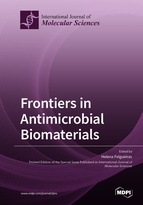Frontiers in Antimicrobial Biomaterials
A special issue of International Journal of Molecular Sciences (ISSN 1422-0067). This special issue belongs to the section "Materials Science".
Deadline for manuscript submissions: closed (30 June 2022) | Viewed by 40599
Special Issue Editor
Interests: antimicrobial agents concomitant; synergistic and additive effects surface functionalization; antimicrobial properties; biomedical therapies; bioactive molecules; green synthesis; environmentally friendly; circular economy; waste materials’ second life
Special Issues, Collections and Topics in MDPI journals
Special Issue Information
Dear Colleagues,
Biomaterials can be used as implantable devices or drug delivery platforms with a significant influence on the patients’ quality of life. Indeed, every year a substantial number of new biomaterials and scaffolding systems are engineered and introduced in the biomedical field with an increased potential for biomedical uses. However, their long-term use can be threatened by the adhesion and proliferation of microorganisms, which can interact and form biofilms, or the formation of fibrosis with cytotoxic responses being very common. Pathogenic microorganisms may cause local infection and, consequent, implant failure, further they can hinder the delivery of therapeutic molecules by specialized delivery platforms, turning them ineffective. Many alternatives have been proposed over the years to prevent such events, including the use of antiseptics and antibiotics or the physical modification of the biomaterial surface, with the incorporation of biomolecules of interest. From specialized polymers and functional groups to silver, and more recently, antimicrobial peptides and natural extracts, different functionalization/modification techniques have been employed in this fight against pathogenic agents.
This Special Issue seeks manuscript submissions that further our understanding about the antimicrobial action of specialized biomaterials, new surface-modification strategies, chemical modifications that can be employed to improve their performance, and even original polymeric chemical structures that can be synthetic manufacture with improved properties from which infection control or eradication can be guaranteed. Submissions on the response of pathogenic microorganisms to these implantable devices and new alternatives to reduce infection transmission and biofilm formation are especially encouraged. The goal is to compile enough information so a complete overview of the current state of the art on antimicrobial biomaterials can be attained.
Dr. Helena Felgueiras
Guest Editor
Manuscript Submission Information
Manuscripts should be submitted online at www.mdpi.com by registering and logging in to this website. Once you are registered, click here to go to the submission form. Manuscripts can be submitted until the deadline. All submissions that pass pre-check are peer-reviewed. Accepted papers will be published continuously in the journal (as soon as accepted) and will be listed together on the special issue website. Research articles, review articles as well as short communications are invited. For planned papers, a title and short abstract (about 100 words) can be sent to the Editorial Office for announcement on this website.
Submitted manuscripts should not have been published previously, nor be under consideration for publication elsewhere (except conference proceedings papers). All manuscripts are thoroughly refereed through a single-blind peer-review process. A guide for authors and other relevant information for submission of manuscripts is available on the Instructions for Authors page. International Journal of Molecular Sciences is an international peer-reviewed open access semimonthly journal published by MDPI.
Please visit the Instructions for Authors page before submitting a manuscript. There is an Article Processing Charge (APC) for publication in this open access journal. For details about the APC please see here. Submitted papers should be well formatted and use good English. Authors may use MDPI's English editing service prior to publication or during author revisions.
Keywords
- antimicrobial agents
- chemical modification
- polymer engineering
- polymer synthesis
- surface functionalization
- antimicrobial agents immobilization
- new drug delivery systems
- microbiocidal
- infection control







